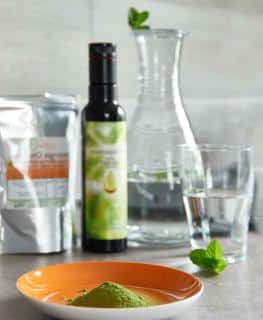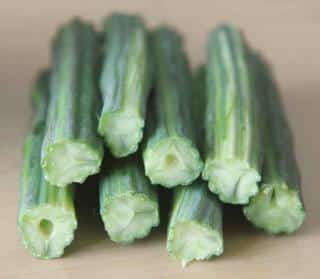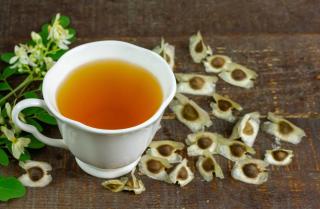

Moringa is a plant that historically originated in India and in other Southeast Asian countries. It is now grown throughout the world in tropical and sub-tropical climates for its medicinal benefits and because it’s so easy to cultivate.
Moringa, a 30-foot tree, is in all respects an excellent medicinal plant. Indeed, all parts of the plant are useful: leaves, bark, flowers, fruits, seeds, and even roots appear as ingredients in medicines and drugs. The plant itself, Moringa oleifera is relatively easy to grow. In some countries, cultivation makes up a significant portion of the economy. All parts of the plant are edible, and studies encourage its use in various ways as regards phytotherapy. Research has proven Moringa as an effective treatment against asthma, cardiovascular diseases, diabetes and other ailments.
 Moringa leaves can be eaten raw, cooked and crushed. In dried and powdered form, they can keep for several months without losing much of their nutritional value.
Moringa leaves can be eaten raw, cooked and crushed. In dried and powdered form, they can keep for several months without losing much of their nutritional value.
Sprinkle a teaspoon of Moringa atop a tossed salad. Use as an ingredient in other recipes has other advantages as well: Moringa is an antioxidant, and adding it to meals and dishes will help leftovers keep for longer, too. For instance, you can add some in guacamole.
Info – Even though it’s clear that leaves and seeds (and, generally speaking, airborne parts) of Moringa oleifera are recognized as being safe, this isn’t always the case for stems and roots. These more woody plant parts may have undesirable side-effects for people who are in specific situations (see the paragraph on side-effects).
The most up-to-date nutritional value database show that a cup of chopped moringa leaves contains:
These high levels of vitamins C and A help protect against cellular damage caused by chemicals in the body. Indeed, they’re antioxidants and they help trap aggressive free radicals, wherever they may be.  For instance, Moringa contains active compounds that promote good eyesight): it keeps blood capillaries in the retina from expanding too much, and ensures the retina doesn’t malfunction. In large part, this is the result of its oxidant activity. Vitamin C helps the body keep a strong and healthy immune system, whereas vitamin A helps maintain mucus health, staving off risks of respiratory and digestive tract ailments. Furthermore, Moringa leaves also contain amino acids that support the immune system as well.
For instance, Moringa contains active compounds that promote good eyesight): it keeps blood capillaries in the retina from expanding too much, and ensures the retina doesn’t malfunction. In large part, this is the result of its oxidant activity. Vitamin C helps the body keep a strong and healthy immune system, whereas vitamin A helps maintain mucus health, staving off risks of respiratory and digestive tract ailments. Furthermore, Moringa leaves also contain amino acids that support the immune system as well.
Be careful! Moringa leaves are relatively safe, but ingesting large amounts of bark or wood pulp may not be a good thing. Actually, even leaves can have a laxative effect if you eat them in large quantities.
Side-effects of eating moringa include the following:
Moringa leaves eaten in larger amounts also led to increased risk of liver and kidney lesions in rats. Don’t eat any moringa supplements if you’re pregnant, if you’re taking medicine against diabetes, or if you have a regular intake of medicines derived from the “cytochrome P450” enzyme family.
According to ethnobotanical archives, moringa has long been used by herborists to alleviate a variety of symptoms, including some that are quite common such as breathing difficulty, cough and other respiratory complications.
 Moringa also contains another class of antioxidants called flavonoids, polyphenols and ascorbic acid: these are most present in leaves, flowers and seeds. Antioxidants combine with free radicals and inactivate them, protecting the body from their oxidation stress, cellular damage, and inflammation. As is always the case for medicine, it’s preferable to talk about moringa with your doctor before adding it as a supplement in your diet. If you notice side-effects, visit your doctor immediately.
Moringa also contains another class of antioxidants called flavonoids, polyphenols and ascorbic acid: these are most present in leaves, flowers and seeds. Antioxidants combine with free radicals and inactivate them, protecting the body from their oxidation stress, cellular damage, and inflammation. As is always the case for medicine, it’s preferable to talk about moringa with your doctor before adding it as a supplement in your diet. If you notice side-effects, visit your doctor immediately.
Read also :
Moringa, the versatile 30-foot tree, stands as a medicinal powerhouse at The Havanna. From leaves to roots, every part offers therapeutic benefits, supporting economies through cultivation. With proven efficacy against asthma, cardiovascular issues, diabetes, and more, Moringa emerges as a holistic remedy. Embrace this botanical marvel for health and prosperity! 🌿💪